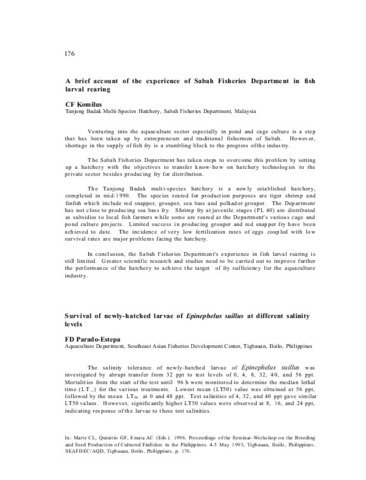A brief account of the experience of Sabah Fisheries Department in fish larval rearing
Share
Abstract
Venturing into the aquaculture sector especially in pond and cage culture is a step that has been taken up by entrepreneurs and traditional fishermen of Sabah. However, shortage in the supply of fish fry is a stumbling block to the progress of the industry.
The Sabah Fisheries Department has taken steps to overcome this problem by setting up a hatchery with the objectives to transfer know-how on hatchery technologies to the private sector besides producing fry for distribution.
The Tanjong Badak multi-species hatchery is a newly established hatchery, completed in mid-1990. The species reared for production purposes are tiger shrimp and finfish which include red snapper, grouper, sea bass and polkadot grouper. The Department has not close to producing sea bass fry. Shrimp fry at juvenile stages (PL 40) are distributed as subsidies to local fish farmers while some are reared at the Department's various cage and pond culture projects. Limited success in producing grouper and red snapper fry have been achieved to date. The incidence of very low fertilization rates of eggs coupled with low survival rates are major problems facing the hatchery.
In conclusion, the Sabah Fisheries Department's experience in fish larval rearing is still limited. Greater scientific research and studies need to be carried out to improve further the performance of the hatchery to achieve the target of fry sufficiency for the aquaculture industry.
Suggested Citation
Komilus, C. F., & Parado-Estepa, F. D. (1996). A brief account of the experience of Sabah Fisheries Department in fish larval rearing. In C. L. Marte, G. F. Quinitio, & A. C. Emata (Eds.), Proceedings of the Seminar-Workshop on Breeding and Seed Production of Cultured Finfishes in the Philippines, Tigbauan, Iloilo, Philippines, 4-5 May 1993 (p. 176). Tigbauan, Iloilo, Philippines: Aquaculture Department, Southeast Asian Fisheries Development Center.
Subject
shrimp culture  ; fish eggs
; fish eggs  ; fishermen
; fishermen  ; fry
; fry  ; pond culture
; pond culture  ; survival
; survival  ; technology transfer
; technology transfer  ; seed production
; seed production  ; fertilization
; fertilization  ; aquaculture
; aquaculture  ; fish larvae
; fish larvae  ; hatcheries; rearing techniques
; hatcheries; rearing techniques  ; aquaculture development
; aquaculture development  ; cage culture
; cage culture  ; crustacean larvae
; crustacean larvae  ; fish culture
; fish culture  ; Penaeus monodon
; Penaeus monodon  ; Epinephelus
; Epinephelus  ; Lutjanus argentimaculatus
; Lutjanus argentimaculatus  ; Lates calcarifer
; Lates calcarifer  ; Giant perch; Giant tiger prawn; groupers
; Giant perch; Giant tiger prawn; groupers  ; Mangrove jack; Borneo, Sabah; Malaysia, Sabah
; Mangrove jack; Borneo, Sabah; Malaysia, Sabah
 ; fish eggs
; fish eggs  ; fishermen
; fishermen  ; fry
; fry  ; pond culture
; pond culture  ; survival
; survival  ; technology transfer
; technology transfer  ; seed production
; seed production  ; fertilization
; fertilization  ; aquaculture
; aquaculture  ; fish larvae
; fish larvae  ; hatcheries; rearing techniques
; hatcheries; rearing techniques  ; aquaculture development
; aquaculture development  ; cage culture
; cage culture  ; crustacean larvae
; crustacean larvae  ; fish culture
; fish culture  ; Penaeus monodon
; Penaeus monodon  ; Epinephelus
; Epinephelus  ; Lutjanus argentimaculatus
; Lutjanus argentimaculatus  ; Lates calcarifer
; Lates calcarifer  ; Giant perch; Giant tiger prawn; groupers
; Giant perch; Giant tiger prawn; groupers  ; Mangrove jack; Borneo, Sabah; Malaysia, Sabah
; Mangrove jack; Borneo, Sabah; Malaysia, Sabah
Taxonomic term
Related items
Showing items related by title, author, creator and subject.
-
Kind, Abundance and Distribution of the Fish Larvae in the South China Sea, Area II: Sarawak, Sabah and Brunei Darussalam
Termvidchakorn, Apichart (Training Department, Southeast Asian Fisheries Development Center, 1999)Fish larvae samples were obtained from 79 stations in South China Sea of the Sarawak , Brunei and Sabah during the pre northeast monsoon season (August - September 1996) and the post northeast monsoon (April - May 1997). ... -
Species Composition and Diversity of Fishes in the South China Sea, Area II: Sarawak, Sabah and Brunei Darussalam Waters
Vidthayanon, Chavalit (Training Department, Southeast Asian Fisheries Development Center, 1999)The collaborative research on species composition and diversity of fishes in the Sabah and Sarawak waters was carried out by using otter-board trawling, through K.K. Manchong, including taxonomic survey for commercial ... -
Distribution, Abundance and Biological Studies of Economically Important Fishes in the South China Sea, Area II: Sarawak, Sabah and Brunei Darussalam Waters
Rumpet, Richard; Awang, Daud; Musel, Jamil; Biusing, Rooney (Training Department, Southeast Asian Fisheries Development Center, 1999)The studies were carried out between 9th July and 3rd August 1996 (3rd cruise) and 30th April and 30th May, 1997 (4th cruise) in the Exclusive Economic Zone of Sarawak and the western part of Sabah. The species distribution, ...





